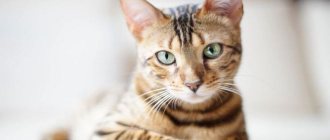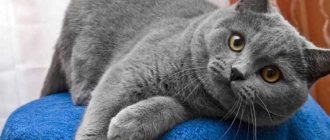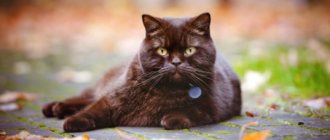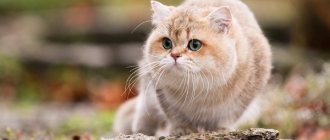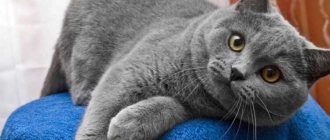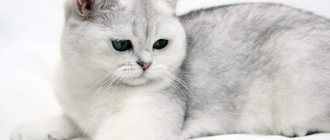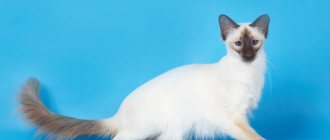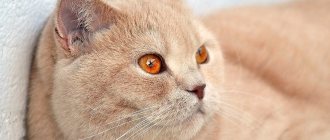The British are no strangers to aristocratic manners and self-sufficiency. Without any advertising or made-up stories, the British cat is truly popular. Worldly vanity is not for them. These cozy, important, personable, stocky cats are especially loved by respectable men, perhaps due to some similarities.
British cats look like women from high society: beautiful and inaccessible. They will not take well to intrusiveness from guests and even the owner. They perfectly express their love for their owner, while being at a distance from him. Therefore, you don’t have to worry that he will get very bored at home alone; most likely, he will even have a great rest without your presence.
British cat - plush joy
Description of the breed
The British Shorthair is a cat breed that was first registered in 1898. It is the result of selection of the Persian breed and the ancestors of wild cats, transported from France by settlers several centuries ago. These are wayward and independent animals, with the nature of an aristocrat, who will not contact strangers.
After several generations, the British Longhair appeared, which in June 1979 was registered by the international organization TICA. Today, the breed has already been recognized by many organizations and its representatives boldly exhibit at various exhibitions and receive awards, recognition, and popularity. These two breeds are similar to each other not only in character, but also in body structure.
Britons are loyal, loving animals who bond well with children, making them suitable for families with small children. They are playful, but not affectionate. If the family is large, they do not choose one person for friendship, but establish friendly relations with all members of the household.
This is a companion breed, but at the same time it should have time and personal space for privacy. They don’t like being picked up or kissed, so they will resist this in every possible way, pushing and turning away.
British longhair cat
British Longhair cats are a type of British cat and in modern times are considered an independent breed. When breeding a British Shorthair cat, kittens with long hair, carrying the gene for long hair, were eliminated, as they were a “reject” of the breed.
Now animals with long hair are considered a separate species and are very popular. British longhair cats carry the blood of shorthair cats (must have their type and bone structure) and Persian cats (they inherit long hair). But it doesn’t always work out this way, and often the animals did not meet the established standards, so there are still no clearly established descriptions of the long-haired “British”.
British longhair cat
History of the origin of the breed
British longhair cats appeared during the development of new coat colors by crossing British and Persian breeds. The gene responsible for long hair is recessive, so the first few generations were short-haired, but subsequent breedings produced kittens with long hair.
Such kittens were considered “defective” and were discarded, but some experts decided to take a different path and began to actively study British cats with long hair. Thus, while breeding long-haired British cats, breeders tried to achieve the ideal look. However, hybrid individuals were born with severe skull defects and soft fluffy hair, so the breeders decided to breed only the most successful hybrids.
Exterior
In general, British Longhairs are no different in appearance from British Shorthairs, except for the length of their coat.
Table 2. Exterior of the British Longhair cat
| Characteristics | Description |
| Head | Large, massive, with full cheeks. Nose straight, short |
| Eyes | Match the color |
| Ears | Small, rounded |
| Body | Massive, with developed muscles and short limbs |
| Tail | Fluffy, with rich undercoat |
| Wool | Medium length, preferably a frill and pants |
Exterior of a cat
British cats have a strong body: powerful short llamas, a thick tail, slightly rounded at the end. Another special characteristic of the breed is its dense, plush coat that does not lie close to the body with a fine structure, as well as a round muzzle with large cheeks, and large bright orange eyes. The paws are round and small. The ears are wide and low set, small, slightly rounded at the tips.
Thick fur with a delicate undercoat, when you stroke or caress it, you get the feeling that you are touching a plush toy. Medium-sized animals with a large body and roundish paws with pink-coffee pads. There may be tufts of wool between the toes, and fluffy woolen trousers and a rich collar at the back. The tail is short, but incredibly bushy - when a cat gets angry and starts waving it, it looks like a huge fan.
The long-haired British breed is of short stature, but with a long body. They have a massive chest, a short neck and a large head with wide cheekbones. If you look closely at the face, it seems that the cat is smiling. The ears are slightly rounded and set wide apart. Eyes can be of different colors: yellow, closer to orange, blue and green.
What is noteworthy is that both animals in a pair must have the same eye color; you cannot cross cats of green-eyed representatives of the breed with blue-eyed cats or a cat with orange eyes.
The pads with whiskers near the small nose give the breed a certain charm; the British have massive whiskers, and the whiskers are long and stick out in lush bushes in different directions. Very cute creatures - it’s impossible not to love them, they are just soft little cuties. The weight of an adult cat is 5-7 kilograms, slightly smaller cats weigh about 4-5 kilograms.
Breed colors
According to the standard, the breed can have several colors, each of them beautiful and unusual in its own way. Most have a single color color - white, ash-blue with a bluish tint, cream shades, chocolate. Black and red long-haired cats look impressive; this color is unusual for the British, but at the same time interesting, and the mystery always causes demand and popularity.
This breed also comes in tortoiseshell and marbled colors. Smoky cats resemble chinchillas, they are also called smokes, cameos. What makes them special is the fact that their undercoat is white - a very attractive combination. The legs, head and back are in darker colors, and the belly and fluffy collar are lighter, sometimes almost white.
[AdSense-B]
The tabby color deserves special attention - smoky with stripes slightly darker in color from the base. The chest and neck have continuous rings, and on the forehead of such cats the letter “M” clearly appears - the dark color of the coat grows in this way. The legs and lush hips are covered with circles - this is a feature of British tabbys with semi-long hair.
This breed also has bicolors, which combine the main color with white. In this case, the standard stipulates that white should not be more than 30% and this is mainly the breasts, neck, and belly.
It is unacceptable to have lightened tips on the coat, like representatives of the Russian Blue cat. The heavily bleached blue color prevents her from receiving the title. Despite its impressiveness, black color is considered the most problematic, since the presence of white hairs or brown spots is unacceptable. Chocolate color is considered both beautiful and complex.
It is worth noting that the fur coat of these animals is very complex. It consists of a two-level structure: a dense undercoat and guard hairs protruding above it. This feature creates the famous pearlescent sheen for kittens with a lilac or blue color.
The world of British cats originally from England is rich and attractive. They are charmingly showy and graceful, as if emphasizing their aristocratic origin.
Description of the breed
The British Shorthair breed is considered quite common. The physical features and character of these cats have been shaped over centuries. The result was a harmoniously developed organism with an incredible variety of colors, an easy-going character and unpretentious maintenance. The breed standard often contains the word "round", and this perfectly describes the physical characteristics of the British. The animal has a high life expectancy - 12-17 years.
Lewis Carroll immortalized the image of the British cat in the Cheshire Cat, who smiled happily from the pages of the book about Alice.
Coat and colors
The coat of the British Shorthair cat is a source of pride and admiration. It feels plush, dense and is an indicator of the pet’s health. The presence of a healthy shine and smoothness indicates the absence of problems. The colors of the British are numerous and within each of them there are many shade options.
Solid coat color can be purple, black, white, red, blue. The chocolate shade is considered the rarest and therefore the most desirable. The more pronounced the “choco” color, the more expensive the individual is. White cats can have different colored eyes.
The rarest monochromatic colors are considered to be fawn and cinnamon (cinnamon).
The tortoiseshell color is found mainly in females, and if a male kitten with this color is born, he is usually infertile. The tortoiseshell color with red and white spots is highly prized.
The color of the chinchilla looks incredibly elegant: cats with shaded silver or golden fur are considered expensive. When paired with lilac, blue or green eyes, they look royal!
The bicolor color is characterized by the presence of spots of black, red, blue on a white background.
The Whiskas color is distinguished by clear gray stripes that clearly stand out against the light coat.
Color point is considered a Siamese color, which adds charm to the British cat. And the tabby color makes the animal look like a tiger due to spots or stripes on the body.
Constitution
The body of the British cat is strong and harmoniously developed. The head is rounded, the cheeks clearly stand out on the large muzzle. The forehead between the ears is not rounded, but smooth. The ears are small, widely spaced, and set low. It is their standing position that is an important indicator of thoroughbred. If the ears droop, then this is either another breed or a mixed-blooded Briton.
The body is dense, muscular, the chest is protruding and quite wide. The front and hind legs are medium-sized, dense. There are five toes on the front paws and four on the hind paws. The tail of a British cat is medium length, rounded at the end.
Males weigh impressively - from 5.5 to 9 kg, and females are much smaller - from 3.5 to 6.5 kg. Animals grow up to 5 years old; upon reaching this age, their growth ends.
Character
The British are independent and fully adapted to living with people. The animals are good-natured and appreciate contact with the owner, but only at their own request. Your impulse to take your pet in your arms or invite him to lie down with you for an afternoon nap will most likely end with the cat leaving for his favorite place. The British Shorthair cat is not one of those who prefers affection and tenderness with its owner.
The animal respects the people living in the apartment and can show interest in their affairs, following the person from room to room. This breed is not known for its playfulness. During adolescence and after sterilization, these cats are usually balanced, and only at the onset of adulthood do they become melancholic and inactive.
They prefer watching what is happening in the house and a pleasant nap to games. Don't be surprised if your Briton spends a lot of time sleeping - this is typical for them. By the way, you can learn more about how cats sleep in a separate article. There you will find interesting facts about cat rest.
Animals also treat children kindly: they do not bite or scratch, unless the baby really hurts the cat. The British also treat other animals calmly, but they prefer loneliness to any company.
You can rarely hear meows from representatives of this breed. They are usually quite silent, but purr eagerly.
The animals are very clean: they can often be found washing themselves. For the same reason, they will not go into an uncleaned tray, and sometimes owners have to put two trays. The British will not eat from a dirty bowl and, if they smell the smell of missing food, they will refuse it.
Character and behavior
According to breeders, a British cat, like Maine Coons, is an ideal addition to a cozy and calm home. The main condition for the breed to be in the house should be psychological comfort and tranquility in the family, and living conditions do not bother them too much. They will fit perfectly in a small apartment or in a huge mansion. They are not prone to aggression, will find a common language with dogs, and will become a child’s best friend.
The British are calm. even somewhat lazy cats. They love to sleep in a cozy place and easily become attached to their owner. Kittens are very inquisitive and incredibly playful - they love to run after a ball, climb on racks, and tumble with each other. If they are interested in something or are bored, they will find something to entertain themselves with. They can throw a piece of candy, a hairpin, a pen, or something else into their teeth with their paw, which they will then play with. Kittens are quite easy to toilet train as they are smart and clean creatures.
Adult cats are the embodiment of calm and peacefulness. They calmly tolerate the absence of their owners at home, in some cases they may not even notice, since they slept all day. But when they hear the steps of the owners who come home, they always greet them and rub against their feet, putting their muzzle up to be stroked. British cats get along well with children; there are cases when they try to lie next to or in the arms of special children, as if sensing their weakness and insecurity.
They get along with other animals in the house or try not to notice them. They are even very friendly with dogs and cats, they make contact with them or bully them, trying to involve them in the game. They are inquisitive creatures, easy to train, and understand the character of their owners. They don’t like excessive attention to them, being carried in your arms, or being squeezed - they’d rather lie on the sidelines, but you can pet them anyway.
Their meowing is similar to some kind of hoarse chirping and they pronounce these sounds muffled and not loud. Each jump from a height is accompanied by this sound - it looks fun and funny.
Features of the British
- They lend themselves well to training and education. These smart animals can follow directions and remember up to 50 words.
- Although they are distinguished by a certain stubbornness, they carry out the owner’s commands accurately. In order for him to fully reveal his character to you, you need to respect his personality and find time to communicate.
- They react perfectly to the appearance of a new animal in the family, without fights or jealousy. They are not characterized by impulsiveness or aggression. They get along well not only with cats, but also with dogs, if they are compatible with each other in character.
- The Briton will be a wonderful friend for a person who is constantly at work, since the lack of communication does not negatively affect the animal.
- These are not tame pets; they would rather lie down close to you, or curl up in a ball, rather than lie in your arms.
- They will never do anything they don’t like and will not accept the annoying affection of their owners.
- When they are small, kittens love affection and ask to be held, but when they grow up, they prefer to keep their distance from their owners. Tenderness and affection in their understanding are manifested in mutual respect and strong emotional contact.
- Although they get along well with children, they may be offended if the child is overly active, so they may try not to show themselves to the children too much.
[AdSense-C]
Aggressive cat: what to do and where to run
Cats are very sensitive creatures with a subtle psychology, so their behavior is significantly influenced by external factors, especially strong emotions such as fear.
A cat that is afraid of something takes a characteristic pose - it presses its ears tightly to its head and moves them back, presses its head and body to the ground, tries to become more invisible, in many cases the animal simply tries to run away.
If it doesn’t run away, it tries to defend itself. A cat that is ready to defend itself looks like this - it raises its paws and swings them, makes sounds similar to spitting, hisses, its fur stands on end (especially on the tail, head and back), its back arches and the animal moves sideways forward, so a cat tries to show its superiority (including in size) and intimidate the enemy.
In most cases, fear is the main cause of aggression in cats. If your pet is timid, you should never deliberately provoke fear; you should also ask your friends and acquaintances to approach the animal slowly, not abruptly, and say kind words as they do so. Only in this way can possible aggression on his part be neutralized.
If the cat is ready to attack, is aggressive, you can spray water on it from a spray bottle, this will cool its ardor. If an animal scratches a smooth surface out of despair, it means that it has lost control of the situation. In this case, you need to put some kind of rug on the cat so that she can sharpen her claws on it, or wrap her in a warm cloth - this way the cat will calm down faster.
Another reason for cat aggression is defense of territory. If there are several animals living in your home, especially if you are the owner of several cats that have reached sexual maturity, they may begin to fight for leadership. To prevent this from happening, introduce the cats correctly in the first days.
The animal that lived with you before should definitely receive more attention - this way it will not feel threatened and will not become jealous. As a rule, cats that live together eat from the same bowls and use the same litter box, but this can cause aggression. Cat utensils should be separated as soon as you notice that the animals are demonstratively avoiding the litter box or fighting around the bowls.
Different smells of animals can cause them to fight, so the manifestation of aggression of one pet towards another can be reduced by bathing them with the same shampoo or spraying them with the same cologne.
Neutered cats, as a rule, are less aggressive, and even sworn enemies can be reconciled. But it is better to castrate animals between the ages of seven months and 1 year, until they acquire the habit of showing aggression and marking territory.
Often those who keep cats confuse their bites with aggression. Small kittens may bite you because their jaws itch (due to teething). Invite them to chew bones, but only those that they cannot chew, or large pieces of meat. Never feed bones from small animals and birds, or chicken bones, as kittens can chew them, causing damage to the gastrointestinal tract.
Often, when the owner tries to pet his pet, he may begin to bite, especially if you want to scratch the cat’s tummy (the stomach for cats is the most vulnerable place, if the animal allows you to scratch its tummy, it means it is subordinate to you and completely trusts you). However, this does not always mean that the cat is aggressive; most likely, your pet is simply not in the mood for communication at the moment or she does not like your affection.
Under no circumstances should you hit cats that show aggression - this will only make the situation worse. If possible, you need to eliminate the cause of the aggression and cool the animal’s ardor with a stream of water.
The following method may also help. You've probably seen how cats behave during fights (swinging their paws at each other, hissing) or mother cats with their children (ruffling them and holding them by the withers). You must do the same - lightly shake the animal by the scruff of the neck, lightly tap it on the nose with your finger, imitate the waving of cats' paws during a fight, hiss at it menacingly and be sure to look the cat in the eyes, since the one who looks away first will “lose” - These are the cat “rules”. You must ensure that your pet looks away, he will become somewhat confused, begin to hesitate, may begin to leave or lick himself - this all means that the animal has recognized you as the leader.
Did you like the article? Click the button and share with your friends! Let there be more happy people and cats!
brit-cats.ru
Pros and cons of the breed
The character of the breed can be called universal; they can get along in any family. It is not difficult to care for them: play, feed them properly. They are a long-lived breed (they live up to 20 years), and always look young, perhaps because they mature only at 3 years.
Those wishing to acquire this breed of cat should remember that they will not lie on their owner’s lap for hours and demand affection. Quite the contrary, the British refuse to be cuddled, stroked or hugged.
It is also useless to train them, although some owners managed to get their pets to greet each other like dogs - the cat began to offer its paw.
British cats adapt both to indoor conditions and to living outdoors, for example, in the country. This breed is very active, so they should have enough space for games, various “climbing areas” so that the cat can jump and move around for pleasure.
Due to the fact that the ancestors of this breed are wild cats, they have excellent health and hunter habits, so they need to be outside as often as possible.
The period of sexual aggravation in the female is quite stormy, with meowing and mating games characteristic of many of their relatives. On average, a British woman gives birth to 4-7 kittens; cats have a well-developed maternal instinct. If a male lives with a cat in the same house, then he can equally take part in taking care of the babies - licking them, warming them with his warmth.
Breeding the British Shorthair cat
British cats are always bred only with British cats. Since 2006, mating between British and Scottish dogs has been officially banned. If you breed a fold-eared cat with a straight-eared cat, some of the offspring will die.
Color compatibility list:
- golden and silver chinchillas are bred only with golden and silver chinchillas;
- if you mix the black group of colors (black, blue, chocolate) and the red group of colors (cream, red, red), tortoiseshell kittens will be born;
- A striped cat (tabby) should also be bred with a tabby cat, but relaxations are allowed here.
The first mating is carried out when the animals are 1 year old. The compatibility of the blood group is taken into account; if it is negative, the pregnancy will be terminated in the first days. On average, a cat gives birth to 5-6 straight-eared kittens.
Important!
Before mating, it is necessary to check the health of each animal.
Care and maintenance of a British cat
Beautiful and thick hair is the wealth of British cats. Unlike Persians, their fur does not bunch up. To do this, it is enough to scratch them 1-2 times a week with a hard brush with rubber tips or a special mitten with teeth, which are available in every pet store or veterinary pharmacy.
During the molting period, you can carry out scratching procedures more often to help the cat renew its coat. This kind of care will help avoid having six throughout the house. Long-haired cats can also be cut or groomed. Modern pet salons offer a number of different services for cats; there is a catalog of hairstyles that can be done for cats and they will look attractive and well-groomed every time.
Since cats shed twice a year in autumn and spring, and their fur is very thick and the animals often lick themselves, it is advisable to give hair-removing drugs during this period. The procedure will help to gently remove hair from the cat’s body and avoid pain and clogging of the stomach and intestines.
Bathing is an activity that most felines dislike. If you are accustomed to the procedure from infancy, then in the future there will be no problems with bathing. You can wash the wool with a mild shampoo, but without fragrances and dyes, with a neutral pH. After the bath, wrap the cat in a soft towel and let the water soak in; do not try to rub, as this can lead to tangling of the fur.
[AdSense-A]
Your pet’s claws also require careful care, as this breed is more susceptible to fungal diseases than others. The claws should not flake or peel, as this may be a signal of the presence of fungal diseases. It is enough to trim the nails once every 2 to 3 weeks. At least once every six months, the cat must be shown to the veterinarian.
With proper care, your furry pet will live up to 15-20 years, which is the average statistical life span for the British. Nature has given them a sharp mind, complaisance and equanimity - they calmly endure visits to the veterinarian, moving, and traveling.
How to raise a cat - habit formation, punishment, praise
Habits, unlike character, are formed throughout the pet’s life. Therefore, owners, with a little effort, can raise a cat correctly. The main thing is to immediately let your pet know who is in charge in the house.
The British are considered very clean. Kids imitate their mothers in everything, adopting her good manners. So, in order to accustom a kitten to the tray, a couple of days are enough. Adults regularly wash themselves and clean their fur. But at the same time, they don’t like it when their owners start fiddling with their fur.
Bad habits
British cats love to drop objects from heights. They like to watch the process of falling. As soon as the owners notice this prank, they should immediately scold the animal. To wean your pet from climbing into prohibited places, you need to treat the surfaces with a special product.
A kitten under four months of age may bite and scratch as it is teething. If this continues into adulthood, then this indicates improper upbringing. Therefore, it is worth initially giving the British toys that can be bitten instead of the owners’ hands.
The most harmless bad habit is checking bags and packages. It is difficult to wean your pet off of this, but it is worth scolding him for such tricks so that a reflex is developed.
Should a Briton be punished or praised?
If a pet has committed an offense, then you need to scold it immediately. Otherwise, he will not understand the essence of the claims. Moreover, the British will harbor a grudge and prefer to be as far away from you as possible.
The carrot and stick rule works with animals, as with people. That is, the animal will develop reflexes not only to punishment, but also to praise. It is advisable to notice positive changes in the cat’s behavior by talking about it out loud.
Proper nutrition and menu for the British
British breed cats are massive, heavy individuals that require a special diet with a high protein content (up to 33 - 34%). In addition, their diet should contain a large amount of vitamins (biotin, calcium, microelements), possibly in the form of vitamin complexes (this way you will eliminate allergies). Representatives of this breed are not picky, so they can be fed both dry food and natural food, but under no circumstances mix these two food options.
To highlight the color of the animal, you can add vitamins with seaweed. After this, the red and tortoiseshell color will be brighter, the lilac color will receive a warmer, pink tone. Even the eyes will have a more intense color. If you give this supplement to cats of cream, blue-cream, or chinchilla color, the color will become darker. There are other foods that affect the color of an animal's fur: liver, carrots.
For example, a natural menu for an adult cat should consist of:
- boiled meat (turkey, lean beef, chicken, rabbit)
- not fatty sea fish;
- porridge (buckwheat, semolina, milk);
- cream.
If you want your cat to eat dry food, then your pet should eat only elite brands of food. For a small kitten, a feeding regimen of 4-5 times a day is necessary. For an adult cat – 2 – 3 times.
It is strictly not recommended to feed representatives of this breed with fatty meat, add spices, salt, smoked meats, poultry with bones, or feed fatty sea fish.
There is no need to overfeed the animal - this can cause obesity, especially since the British have a tendency to this disease. In the early stages, kittens prefer dairy products - cottage cheese, kefir, yoghurt. If you get a kitten that is accustomed to homemade food, then it is not necessary to retrain it to feed.
You can also add quail eggs, beef, veal to your cats’ diet, and you can also feed them a little boiled chicken. It is undesirable to give fish, fish heads and entrails - such food will not lead to anything good, and the bones can also get stuck in the throat.
Features of the appearance of the breed
Representatives of the British breed are distinguished by their stockiness and unusual plush fur. Pets come in medium and large sizes. They are beautifully built and have good muscles. The fur does not adhere to the body, which is why pets look like plush toys. At the same time, it has a uniform length; often the undercoat has a darker color than the main shade of the coat. The limbs are short but strong.
The British breed is characterized by a large head with pronounced cheekbones. The eyes of the pets are wide open, the nose is straight, the ears are quite short, because of this the muzzle looks more rounded.
The color of the British is not only blue. Although mostly people have pets of this shade. Cats may not be the same color; uneven coloring of the coat is also allowed. Each shade has several variations, for example, lilac is divided into three types: light, medium, dark.
The British breed inspired Lewis Carroll to create the Cheshire Cat. The character was based on the wide and slightly smug muzzle of the British.
In fact, according to the breed standard, at least thirty types of colors are known:
- black;
- white;
- creamy;
- chocolate;
- lilac;
- ginger;
- tortoiseshell;
- marble;
- chinchilla;
- brindle;
- mackerel;
- smoky;
- tabby;
- spotted.
British diseases
These cats are distinguished by excellent health and are considered a fairly hardy breed. But at the same time, there are diseases to which they are susceptible. This breed has two types of blood at once - A and B, which can cause problems if you decide to start breeding cats.
British Shorthair cats have about 36% type B blood. If they mate with type A cats, a litter of both types A and B may result. Kittens with type A blood are relatively healthy individuals, but die within 24 - 72 hours, which is called “disappearing kitten syndrome” and is explained by the presence of B antibodies, which are produced against type A. Antibodies can pass to the kitten with mother’s milk, where they fight the baby’s red blood cells and kill them.
Using a special DNA test, you can determine what type of blood a kitten has and avoid their death. Other diseases include: dental problems, tendency to be overweight, infectious diseases. The latter can be prevented by timely vaccination of the animal.
It is necessary to vaccinate the animal and give anthelmintic drugs in accordance with the schedule in order to avoid infection with various infectious diseases and parasites. The British by nature have excellent health and resistance to disease, but preventive procedures and regular examination by a veterinarian once a year are the minimum that every loving owner should do for their pet.
Nutrition
We promised to tell you about nutrition, and now the time has come. Let us immediately draw your attention to the fact that a properly selected diet is the key to good health and excellent mood for your pet. Thick and beautiful coat, healthy teeth and strong claws are primarily the result of a well-balanced diet.
Moreover, recognizable brands and advertising are not always an indicator of the quality of food for an animal, and besides, the British are very prone to being overweight. Therefore, to ensure that your cat’s food includes all the necessary vitamins and beneficial microelements, we recommend that you consult a veterinarian. A competent specialist will always help you accurately select food and calculate portions, which in turn will ensure good digestion for your cat.
The daily feeding rate is determined according to individual criteria and the age of the kitten or cat. For example, it is enough to feed an adult cat twice a day, but it is recommended to give food to a pregnant or lactating cat four to five times a day.
Veterinarians recommend breastfeeding for babies who are not even two months old. But in cases where this is not possible, cow's milk or even goat's milk is quite suitable for feeding. The main thing is to maintain frequency and give milk to the kitten every four hours.
After two months, you can slightly change the diet and slowly add porridge, boiled meat and dairy products to the menu. And after the furry baby is three months old, you can give him special canned food. The number of meals is gradually reduced until the cat turns one year old. Then it can be transferred to the norm of an adult animal.
Buying a British kitten
The difficulty of choosing for the future owner can only be caused by the need to determine the color of the future pet, since there is definitely no shortage of nurseries in Russia. There are almost 300 of them, and each of them offers a wide selection of kittens of various colors.
You should wait to buy a kitten until it is 3-4 months old. Despite the external charm of all kittens, you should remember that British cats should not have skinny paws, giant ears, a long elongated nose and small, deep-set eyes.
Even if you saw a cat at an exhibition and fell in love with it, don’t rush into buying it. Visit a nursery, or better yet several. Look not only at the kittens, but also at their mothers.
It is important to find out the pedigree of a cat, because it is not just that you buy an expensive animal from a nursery; it must be possible to trace the ancestors of at least 4 generations.
Each ancestor must be identified by the abbreviation BRI, which stands for British Ring. From a good breeder you will always, without any questions, receive all the certificates about vaccinations, taking anti-worm medications, castrations/sterilizations, which will be stipulated in the clauses of the purchase and sale agreement, including participation in exhibitions.
It is easy to recognize a healthy kitten: it is active, playful and inquisitive. Play with the kitten, ask the breeder in more detail about its habits.
Cost of cats
The price is influenced by many indicators and, first of all, the presence of a pedigree and the status of the nursery. Depending on the different colors, the cost changes - if it is a rarer color, the kittens are sold more expensive, if it is a more common and less valuable color, the kittens are cheaper. Also, the price of cats is higher than the cost of males. Females are more often bought to have offspring or for their more docile nature.
Today in the nursery the cost of long-haired purebred cats with an impeccable pedigree ranges from 400 to 1400 dollars. If you don’t need a handsome purebred, then you can buy a mixed breed from home owners much cheaper. For example, if you buy a kitten second-hand, it will cost you 1,000 rubles.
Health
British cats are not susceptible to hereditary diseases and have good health.
Due to low activity, this breed is prone to obesity. Therefore, care should be taken to ensure that the pet does not overeat and that its diet is balanced. Remove the food bowl after the animal has had enough. A house on a perch will add activity to your pet’s everyday life. Offer your cat games with interactive toys: some may develop a hunting instinct and, thanks to this, animals are active even in adulthood.
Sometimes the British get their eyes watering. This is not a disease, but a feature of the breed. Remove secretions every day with a sponge soaked in chamomile infusion, unsweetened black tea, or a special product purchased at a pet store.
Like other animals, Britons can become victims of fleas, ticks and worms. Carry out an examination and give your pet the necessary medications. Visit your veterinarian regularly to help avoid health problems.
History of the breed
The history of the breed stretches back centuries. More than 1000 years ago, back in 940, in every settlement in Wales for nine buildings there lived such an animal with certain inherent qualities. The price of such an animal was very high, they bought it with whole families, took great care of it, took care of it, created the best conditions, but also received enormous benefits in return! After all, the British saved entire settlements from the invasion of mice.
Sometimes it’s even hard to imagine how much they have changed over this millennium! The breed acquired its plump cheeks only in the 70s of the 20th century, presumably from mating with the Chartreux breed. The appearance was slightly adjusted, and large, wide-set Persian eyes were added to the appearance.
[AdSense-B]
Gradually, the animal, which became a symbol of England and recognized by all philological organizations in the world, acquired its current appearance: a strong animal, with plump paws, a round muzzle and short thick hair.
The first person to pay due attention to the breed was the Englishman Harrison Weir (1824-1905). He became the first felinologist expert who made yesterday's mouse catchers into a breed popular throughout England by the beginning of the last century.
You can find various names for this breed until the 40s of the last century. The most sought-after cat was the blue cat, whose coat color ranged from a close-to-gray blue to a deep, dark shade. The First World War left its mark not only on people’s lives, but also brought cats of this breed to the brink of extinction.
After 1945, the year the Second World War ended, the breed had to be restored through crossings with other shorthair cats, as well as Persian, Russian Blue, Chartres and others.
It was impossible to avoid the undesirable features of other breeds that appeared in appearance (snub nose, soft coat, underbite). As time passed, these shortcomings were smoothed out, which led to the abandonment of outcrosses. The development of the breed was quite active, and by now a massive animal has formed, with large, heavy bones and round eyes.
The first representative of the breed entered the United States of America in 1901, however, the CFA recognized them as an independent breed only in 1950, and the first club in the country appeared more than 20 years later. The breed came to the Soviet Union from the territory of Germany (formerly the Federal Republic of Germany) in 1989-1991.
History of the origin of the British Shorthair cat breed
The history of the British Shorthair began many centuries ago. It’s nice to think that the country of origin of the British is Great Britain. However, the ancestors of the British were popular back in Roman times. Back then, pets were valued for their hunting instinct. They saved crops and protected houses from small rodents. Back then they were distinguished by their elegance and thin legs.
The breed in its modern sense originated in the 19th century. Then wild relatives significantly improved the gene pool of the British. Until the 19th century, the British cat was formed under the guidance of nature itself. As a result, after several centuries we have a pretty, well-proportioned animal. If their development history were brief, then their appearance would be simpler.
From Great Britain the pet began to be transported to different parts of the world, and so the cat spread throughout the world.
Interesting!
It is believed that it was the Romans who brought cats to the British Isles. According to another version, the British came to Europe during the Crusades, and came to England with French sailors.
The first official cat show took place in 1871. It was organized by a man named Harrison Ware. The next thing he did was develop a rating system, convene the participants and agree on the venue. The morning after the exhibition, the newspapers were full of photographs of British aristocratic cats. This is how British cats gained their first popularity. A little later, a generally accepted breed standard and the first official kennels appeared.
Interesting!
The breed is rarely found in the United States, but in the UK it occupies a leading position in popularity.
After the Second World War, most of the purebred British disappeared. To restore the population, cats began to be crossed with Russian Blue cats and Persians. For a long time, official phenological organizations did not want to recognize the new breed due to mixed blood. However, in 1970 they were recognized by the ACFA, and in 1980 by the CFA. In the same 1980, British dogs were brought to Moscow.
Popularity of the breed in the world
Germany, Great Britain, Scandinavian countries, Russia, and almost all of Europe are the places where British cats are most popular.
Kittens of this breed can be seen every day on TV in Whiskas food advertisements. In a series of commercials, the main roles are played by silver tabby cats from the German Silver Treasure cattery. A whole family starred in the commercials: the cat Simba, and his sons Jamie, Selly, Chobi, Jesse, Shamu, Bailey, Chiara.
When one of the IKEA furniture hypermarkets opened in Novosibirsk in 2008, it was decided to be the first to launch a cat, which corresponds to the old Russian tradition. 4 representatives of different breeds applied for this role, but it was the large-sized British tabby-colored breeder Svetlana Anisimova who was chosen.
Conclusion
British cats are, first of all, good friends for people who do not have much time to communicate with an animal. They get along well with other animals in the house, love children, are not picky about food, and require moderate care and can be trained. If you are looking for a pet with similar criteria, find out more about the representatives of this particular breed, they will become loyal and good friends for you.
For all their equanimity, cats of the British breed are very sweet, and sometimes shy, inquisitive and do not intend to bother their owners at all. Being left alone is not a tragedy for them, but an opportunity to get a good night's sleep or spend quality time. Be sure that when you bring this cat into your home, you will fall in love with her forever!
Character traits
The character of the British is formed before one and a half years. If you miss time, it will be difficult to re-educate the cat.
The British breed has a special temperament. Cats do not tolerate humiliation and rudeness. With the right approach, they behave in a dignified manner, do not destroy the house, do not bite, or spoil things. You cannot limit their freedom by trying to grab them and carry them in your arms all the time. If the owner shows aggression towards the pet, then in the future the animal will hide and may even refuse food.
The pet will not show its owners weaknesses. He will not take revenge, like representatives of another breed, by tearing off wallpaper or ruining shoes. The British may spend a lot of time at home alone. But, despite their independence, they need attention and affection.
Representatives of the British breed are extremely patient; they do not react to minor mischief. Therefore, they get along well with all the inhabitants of the house. But if a cat is hurt, it will defend itself by using its teeth or claws.

